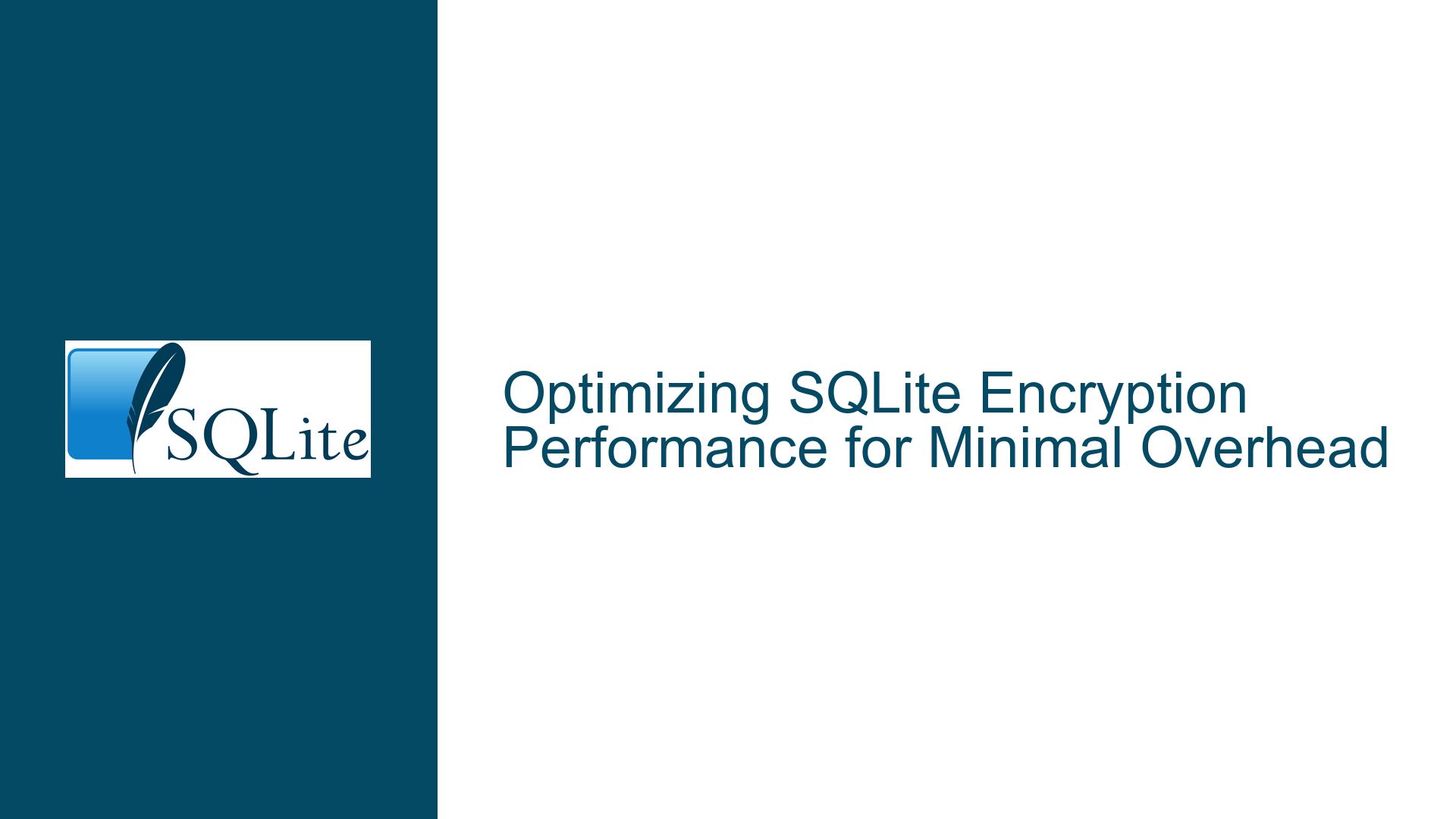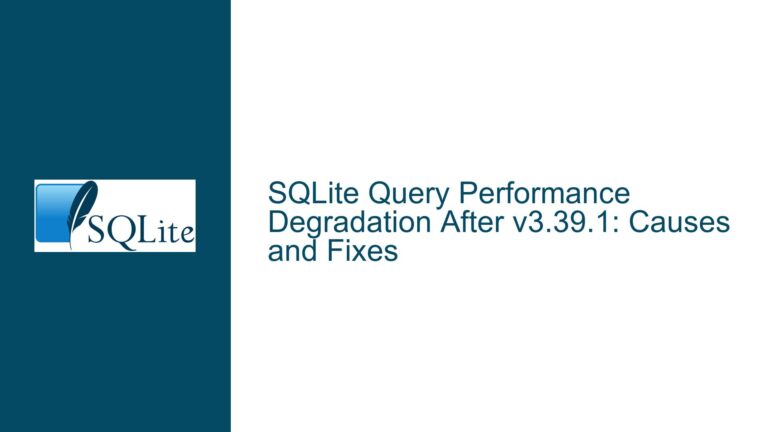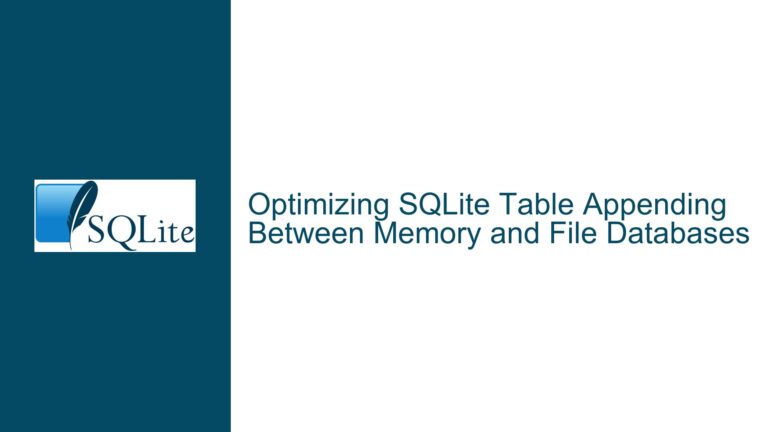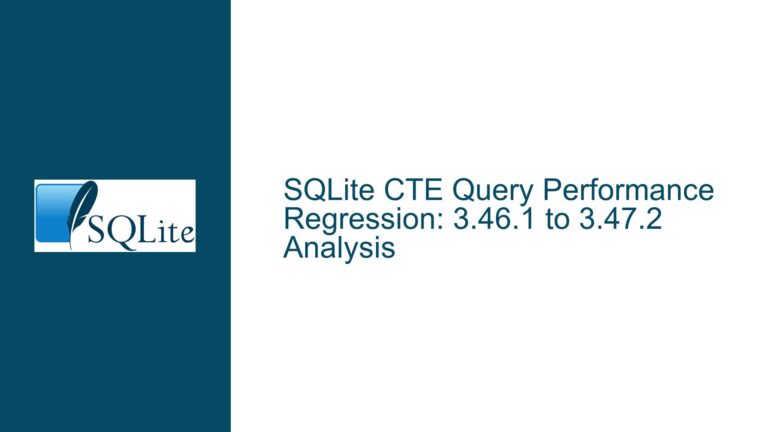Optimizing SQLite Encryption Performance for Minimal Overhead
Understanding SQLite Encryption Performance Overhead
When working with SQLite in environments where data security is paramount, encryption becomes a critical component of the database setup. However, encryption inherently introduces performance overhead due to the additional computational resources required for encrypting and decrypting data. In the context of SQLite, this overhead can manifest as increased latency during database access operations, such as reads and writes. The goal is to minimize this overhead while maintaining robust security.
The performance overhead of encryption in SQLite is influenced by several factors, including the encryption algorithm used, the implementation of the encryption library, and the specific configuration of the database. For instance, using SQLCipher, a popular extension for SQLite that provides transparent 256-bit AES encryption, can add significant latency compared to an unencrypted database. In the case described, SQLitePCLRaw.bundle_e_sqlcipher, a NuGet package that bundles SQLCipher, adds approximately 400ms to database access operations, whereas an unencrypted database completes the same operations in around 200ms. This doubling of access time is a substantial performance hit, especially in applications where low latency is critical.
To understand the performance overhead, it’s essential to break down the components involved in the encryption process. When a query is executed on an encrypted SQLite database, the following steps occur: the encrypted data is read from disk, decrypted in memory, processed by the SQLite engine, and then re-encrypted before being written back to disk. Each of these steps introduces latency, with the decryption and encryption phases being the most computationally intensive. The choice of encryption algorithm plays a significant role in determining the extent of this latency. AES-256, while highly secure, is more computationally expensive than lighter algorithms like AES-128 or ChaCha20.
Moreover, the implementation of the encryption library can also impact performance. SQLCipher, for example, is designed to be highly secure but may not always be the most performant option. Other encryption libraries or custom implementations might offer better performance, albeit potentially at the cost of reduced security. Additionally, the configuration of the database, such as the page size and cache settings, can influence how encryption affects performance. A larger page size might reduce the number of encryption/decryption operations required, thereby improving performance, but this comes with trade-offs in terms of memory usage and disk I/O.
In summary, the performance overhead of SQLite encryption is a multifaceted issue that depends on the encryption algorithm, the implementation of the encryption library, and the database configuration. Understanding these factors is crucial for optimizing the balance between security and performance.
Identifying the Root Causes of Encryption-Induced Latency
The latency introduced by encryption in SQLite can be attributed to several root causes, each of which must be carefully examined to identify potential areas for optimization. The primary causes include the computational cost of the encryption algorithm, the efficiency of the encryption library, and the impact of database configuration on encryption performance.
The computational cost of the encryption algorithm is one of the most significant factors contributing to latency. AES-256, the algorithm used by SQLCipher, is known for its strong security but requires substantial computational resources. Each encryption and decryption operation involves multiple rounds of complex mathematical transformations, which can be time-consuming, especially on devices with limited processing power. In contrast, lighter encryption algorithms like AES-128 or ChaCha20 may offer better performance, though they may not provide the same level of security. The choice of algorithm should therefore be guided by the specific security requirements of the application and the acceptable level of performance overhead.
The efficiency of the encryption library is another critical factor. SQLCipher, while widely used and highly secure, may not always be the most performant option. The library’s implementation, including how it handles key management, memory allocation, and I/O operations, can significantly impact performance. For example, if the library performs frequent memory allocations or uses suboptimal I/O strategies, this can introduce additional latency. Custom encryption libraries or alternative implementations might offer better performance, but they may require more effort to integrate and maintain. Additionally, the version of the encryption library being used can also affect performance, as newer versions may include optimizations or bug fixes that improve efficiency.
Database configuration plays a crucial role in determining how encryption affects performance. The page size of the database, for instance, can influence the number of encryption and decryption operations required. A larger page size means that more data is encrypted or decrypted in a single operation, which can reduce the overall number of operations and thus improve performance. However, larger page sizes also increase memory usage and can lead to more significant disk I/O, which may offset some of the performance gains. Similarly, the cache size and other database settings can impact how encryption affects performance. For example, a larger cache might reduce the frequency of disk reads and writes, thereby reducing the number of encryption/decryption operations required.
In addition to these primary causes, other factors can contribute to encryption-induced latency. For instance, the hardware on which the database is running can have a significant impact. Devices with faster processors and more memory will generally handle encryption more efficiently than those with limited resources. Similarly, the operating system and its configuration can influence performance. For example, some operating systems offer hardware-accelerated encryption, which can significantly reduce the computational cost of encryption operations.
In conclusion, the latency introduced by encryption in SQLite is the result of a combination of factors, including the computational cost of the encryption algorithm, the efficiency of the encryption library, and the configuration of the database. Identifying and addressing these root causes is essential for optimizing the performance of an encrypted SQLite database.
Strategies for Minimizing Encryption Overhead in SQLite
Minimizing the performance overhead of encryption in SQLite requires a multifaceted approach that addresses the root causes of latency while maintaining the necessary level of security. The following strategies can help achieve this balance, focusing on optimizing the encryption algorithm, improving the efficiency of the encryption library, and fine-tuning the database configuration.
Optimizing the Encryption Algorithm: The choice of encryption algorithm has a significant impact on performance. While AES-256 is highly secure, it is also computationally expensive. For applications where performance is critical, consider using a lighter encryption algorithm such as AES-128 or ChaCha20. These algorithms offer a good balance between security and performance, though they may not be suitable for all use cases. When selecting an algorithm, it’s essential to consider the specific security requirements of the application and the potential trade-offs in terms of performance. Additionally, some encryption libraries offer configurable key sizes, allowing you to choose a key size that provides the desired level of security without excessive computational cost.
Improving the Efficiency of the Encryption Library: The implementation of the encryption library can significantly impact performance. SQLCipher, while widely used, may not always be the most performant option. Consider exploring alternative encryption libraries or custom implementations that offer better performance. When evaluating encryption libraries, look for features such as efficient memory management, optimized I/O operations, and support for hardware-accelerated encryption. Additionally, ensure that the library is up to date, as newer versions may include performance optimizations or bug fixes. If using a custom implementation, consider profiling the code to identify and address any performance bottlenecks.
Fine-Tuning Database Configuration: The configuration of the SQLite database can influence how encryption affects performance. One key parameter to consider is the page size. A larger page size can reduce the number of encryption and decryption operations required, thereby improving performance. However, larger page sizes also increase memory usage and can lead to more significant disk I/O, so it’s essential to find the right balance. Experiment with different page sizes to determine the optimal setting for your application. Additionally, consider adjusting the cache size and other database settings to further optimize performance. For example, increasing the cache size can reduce the frequency of disk reads and writes, thereby reducing the number of encryption/decryption operations required.
Leveraging Hardware Acceleration: Hardware-accelerated encryption can significantly reduce the computational cost of encryption operations. Many modern processors include dedicated instructions for encryption, such as Intel’s AES-NI or ARM’s Crypto Extensions. Ensure that your encryption library and database configuration take advantage of these hardware features. Additionally, consider running the database on hardware that supports hardware-accelerated encryption, as this can provide a substantial performance boost.
Profiling and Benchmarking: To identify and address performance bottlenecks, it’s essential to profile and benchmark the database under realistic conditions. Use profiling tools to measure the performance of encryption operations and identify any areas where improvements can be made. Additionally, conduct benchmarks to compare the performance of different encryption algorithms, libraries, and database configurations. This data-driven approach can help you make informed decisions about how to optimize the performance of your encrypted SQLite database.
Implementing Caching and Batch Processing: Caching can help reduce the number of encryption and decryption operations required by storing frequently accessed data in memory. Consider implementing a caching layer that stores decrypted data in memory, reducing the need to repeatedly decrypt the same data. Additionally, batch processing can help minimize the overhead of encryption by grouping multiple operations together. For example, instead of encrypting or decrypting data one record at a time, process multiple records in a single batch. This approach can reduce the overall number of encryption/decryption operations and improve performance.
Considering Alternative Encryption Strategies: In some cases, it may be possible to reduce the performance overhead of encryption by adopting alternative encryption strategies. For example, instead of encrypting the entire database, consider encrypting only sensitive data fields. This approach can reduce the amount of data that needs to be encrypted and decrypted, thereby improving performance. Additionally, consider using column-level encryption, where only specific columns are encrypted, rather than the entire database. This strategy can provide a good balance between security and performance, though it may require more complex application logic.
Monitoring and Continuous Optimization: Finally, it’s essential to continuously monitor the performance of the encrypted database and make adjustments as needed. Performance requirements and security threats can evolve over time, so it’s important to regularly review and optimize the encryption strategy. Use monitoring tools to track the performance of encryption operations and identify any emerging bottlenecks. Additionally, stay informed about new developments in encryption technology and consider adopting new algorithms or libraries that offer better performance or security.
In conclusion, minimizing the performance overhead of encryption in SQLite requires a comprehensive approach that addresses the root causes of latency while maintaining the necessary level of security. By optimizing the encryption algorithm, improving the efficiency of the encryption library, fine-tuning the database configuration, leveraging hardware acceleration, profiling and benchmarking, implementing caching and batch processing, considering alternative encryption strategies, and continuously monitoring and optimizing performance, it is possible to achieve a balance between security and performance that meets the needs of your application.






